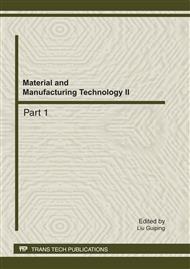p.177
p.183
p.189
p.194
p.199
p.204
p.210
p.215
p.221
Properties of Multi-Walled Carbon Nanotube / Polymethyl Methacrylite Nanocomposite Prepared via a Modified Coagulation Method
Abstract:
The aim of this study is to produce MWCNT/PMMA nanocomposite with enhanced properties through a modified coagulation method. Samples were prepared in respect to various high filler loadings (1%, 3%, 5%, 7% and 10% wt.). Standard ASTM D790 flexural test was used to evaluate the mechanical properties of the composites. The morphology and surface fracture was observed via Scanning Electron Microscopy (SEM). Thermal stability and electrical conductivity of the composites as a function of MWCNT concentration were measured using Thermo Gravimetric Analyzer (TGA) and UHT Meter, respectively. Flexural strength and flexural modulus of MWCNT/PMMA nanocomposite showed an improvement up to 24.1% and 107.7% compared to the neat PMMA. It was found that the thermal stability and electrical conductivity of the MWCNT/PMMA nanocomposite improved as the concentration of the MWCNT filler increased. These studies therefore demonstrated that MWCNT/PMMA nanocomposite prepared via a modified coagulation method able to successfully improve thermal stability, electrical conductivity and mechanical properties of PMMA.
Info:
Periodical:
Pages:
199-203
Citation:
Online since:
September 2011
Authors:
Price:
Сopyright:
© 2012 Trans Tech Publications Ltd. All Rights Reserved
Share:
Citation:


